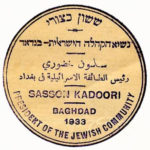Carsten Dippel – Das vergessene Pogrom von Bagdad
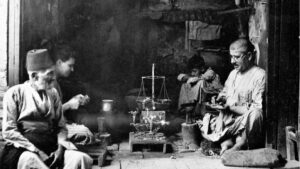
Jüdische Gemeinde mit langen historischen Wurzeln: In Bagdad war rund ein Fünftel der Bewohner in den 1920er-Jahren jüdisch. (akg-images / Collection Dupondt) Source: Deutschlandfunk Kultur
Deutschlandfunk Kultur – Seit sechs Jahren gibt es einen internationalen Gedenktag an den Farhud. Doch nur wenige kennen das Pogrom von Bagdad, das die mehr als 2500-jährige Geschichte jüdischen Lebens im Irak beendete.
Salima Murads Stimme war in der arabischen Welt bekannt. Salima Murad war Jüdin, verheiratet mit einem Muslim. Im alten Irak war das möglich. Noch in den 1920er-Jahren machte die jüdische Bevölkerung Bagdads gut ein Fünftel der Bewohner aus. Tür an Tür lebten seit Jahrhunderten Juden und Muslime zusammen.
Doch dann brach im Kriegsjahr 1941 etwas über die jüdische Gemeinde herein, das niemand kommen sah: der Farhud. Am 1. und 2. Juni tobte binnen 30 Stunden ein Mob im jüdischen Viertel Bagdads. Muslime schlugen auf ihre jüdischen Nachbarn ein. Sie plünderten Geschäfte, vergewaltigten Frauen, töteten mindestens 130 Menschen, manche sprechen von mehreren Hundert.
[…]
Rabbi Sasson Kadouri war ein hoch angesehener Mann. Der langjährige Oberrabbiner von Bagdad blieb bis zu seinem Tod 1971 bei seiner Gemeinde, die er nicht im Stich lassen wollte. Sein Enkel, der Künstler Joseph Sassoon Semah, wuchs in Israel auf und hatte nie eine Chance, seinen Großvater kennenzulernen. Aber die Geschichte seiner Familie spiele für ihn als Künstler eine wichtige Rolle, sagt Semah.
Semahs Eltern haben über ihr Leben im Irak kaum gesprochen. Im zionistischen Staat habe ihr Narrativ lange Zeit keinen Platz gefunden, beklagt er. So sei es nicht erwünscht gewesen, ihr arabische Muttersprache zu hören. Eine Stimme, wie die der Sängerin Salima Murad, sucht man im israelischen Radio vergeblich.
„Es war in einem rechtlichen Sinne nicht verboten. Aber Schande über Dich, wenn Du Arabisch sprachst“, berichtet Semah. Dies zeichnet auch der Historiker Dan Diner in seinem jüngsten Buch „Der andere Krieg“ nach:
„Die babylonische, die Bagdader, die irakische Judenheit und die jüdische Heimstätte waren einander eigentlich fremd geblieben. Die zwischen ihnen liegende Syrische Wüste markierte ein sowohl faktisches wie mentales Hindernis.“
https://www.deutschlandfunkkultur.de/80-jahre-farhud-das-vergessene-pogrom-von-bagdad
On Friendship / (Collateral Damage) – IV How to Explain Hare Hunting to a Dead German Artist [The usefulness of continuous measurement of the distance between Nostalgia and Melancholia] (September 2021 – June 2022)
 Introduction
Introduction
In 2021/22 the 100th anniversary of the birth of artist Joseph Beuys will be celebrated in Europe, among others with the special event ‘Beuys 2021. 100 years’. Twelve cities and twenty institutes in North Rhine-Westphalia in Germany will be organizing exhibitions, theatre and other activities to celebrate this anniversary. (see for more info https://beuys2021.de/en).
Joseph Heinrich Beuys (1921, Krefeld- 1986, Düsseldorf) is one of the most influential German post-war artists, who became particularly famous for his performances, installations, lectures and Fluxus concerts. But who was Beuys truly? Joseph Beuys mythologized his war history as a National Socialist and Germany’s problematic and post-traumatic past. After Word War ll Beuys transformed himself from perpetrator to victim. His service in the Luftwaffe did not offset his artistic practice. During this 100-years event none of these controversial aspects of Beuys’ work, values and ideas are focused upon. As part of this celebration it is high time to add a more critical eye on Beuys’ work and his relationship to Germany’s post-war history.
Project
On Friendship / (Collateral Damage) IV -How to Explain Hare Hunting to a Dead German Artist [The usefulness of continuous measurement of the distance between Nostalgia and Melancholia] (‘Hasenjagd’ is the code word for killing Jews during World War II) centers on Joseph Beuys and Joseph Sassoon Semah takes us on a journey of critical analysis of Beuys. Linda Bouws is the curator.
Art cannot be seen disengaged from society – which political, social and cultural implications does Joseph Beuys’ work show us?
How do work and politics relate in Beuys’ work, what is myth and what is reality? Did Beuys free art of power and financial gain or did he use his art with the purpose to forget or idealize his own war history and that of Germany? Does his transformation from perpetrator to victim fit into post-war Germany? How did Beuys use his ‘visual codes’, that have disappeared, and secret symbols? How must we interpret Beuys in this celebratory year 2021?
Joseph Sassoon Semah has done extensive research into Joseph Beuys’ work, values and ideas and based on this research and texts he will analyse the deeper meaning of the (secret) symbols used by Joseph Beuys for ‘On Friendship / (Collateral Damage) IV- How to Explain Hare Hunting to a Dead German Artist [The usefulness of continuous measurement of the distance between Nostalgia and Melancholia]’. He will react to them using new monumental sculptures and a series of old and new drawings, performances, texts and meetings.
This project wants to raise public awareness about the missing information on Joseph Beuys. Information that has been disregarded during this celebratory year or has been evaded to avoid uncomfortable confrontations. A new project about the reading of Beuys’ ‘shrouded’ art by the Jewish-Babylonian artist Joseph Sassoon Semah.
We will cooperate with among others with Gerard-Marcks-Haus Bremen, Goethe-Institut Amsterdam, Duitsland Instituut Amsterdam, Lumen Travo Gallery, Redstone Natuursteen & Projects, the Jewish Historical Museum and The Maastricht Institute for the Arts. After completion of the manifestation a complementary publication will be compiled.
Metropool International Art Projects
Contact: Linda Bouws
lindabouws@gmail.com
Mob +31(0) 620132195
1 June 2021 – International Farhud Day
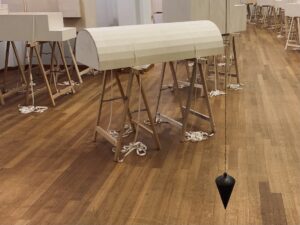
Kunstmuseum Den Haag, Joseph Sassoon Semah, exhibition Over Vriendschap…. (29 August 2021) Architectoral model based on the mass grave of Jews in Baghdad – Farhud 1941
Sarah, was an 11-year-old nanny from Kurdistan living in Baghdad who witnessed the Farhud.
“ Eventually, the Farhud broke out, on the Eve of the Feast of Shavuot (Pentecost). They went out and started killing people. They would break into houses at night to rob and kill.
(…) In Baghdad, there were also Muslims who loved the Jews. Such Muslims would help their Jewish neighbour’s by writing on their neighbours’ doors ‘this house is Muslim’.
If a house had this sign, the rioters wouldn’t touch it. But if a house didn’t have such a sign, they would break in and kill those who were inside.” (Blog Dorota Molin, in Times of Israel, 5 May 2021)
The Art Of Cooking – Bamia With Rice
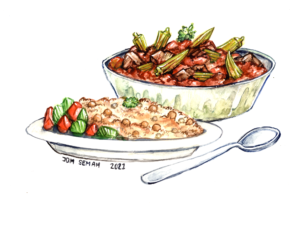 Bamia (Okra Stew) is an important dish in Iraqi cuisine, it is a simple dish and yet a delicious dish that can be made with or without meat.
Bamia (Okra Stew) is an important dish in Iraqi cuisine, it is a simple dish and yet a delicious dish that can be made with or without meat.
Bamia (Okra) itself is not the most popular vegetable out there, but once you can look past its slimy structure it is actually really tasty.
Bamia has a rich sweet and earthy flavor which is well contrasted with the acidity of tomato.
Bamia as well as other stew are great to eat with rice – in this recipe, I will teach you how to make your rice a little bit more exciting!
Ingredients:
Okra 500 gram (you can find Okra at your local Mediterranean shop, It should be fine for both fresh or frozen)
Lamb meat 500 gram (it could be made with either meat or chicken)
Can of peeled tomatoes
Tomato paste
2 onions
Garlic
White rice (I myself prefer Basmati rice, but any white rice will do)
Can of chickpeas
Salt & Pepper
Dried bay Leaf
Cumin
Cooking oil
Bamia (Okra Stew):
Start with heating up a layer of oil in a big pot.
Season the meat with salt and pepper and add it to the hot oil.
Make sure all sides of the meat get cooked do not worry about the pot getting too sticky.
Next add some cumin, diced garlic, and diced onion.
When the onion turns translucent, add some tomato paste together with the can of peeled tomatoes.
Use the liquid to clean the bottom of the pan and mix the flavor into the sauce.
Rinse the okra and add it to the pan, add enough water to cover all ingredients, and let it simmer for an hour or more (the more the better).
Make sure it does not get too dry while simmering on the stove.
When the meat is soft enough (prick the meat with a fork to check if it is ready).
Taste for salt before serving.
Rice:
Let’s try to make exciting rice, for the extra pleasure of eating the Bamia.
First of all, measure the rice into a cup and level the top, and then rinse it in cold water – make sure to remove all the dirt – prepare a measured amount of water equal to 1 and a half cup that you used for the rice.
In a deep frying pan add a layer of cooking oil, when the oil is hot add a dried bay leaf and chopped onions, and some cumin.
When the onion turns translucent, add some tomato paste and be sure to stir frequently.
As the mixture starts to dry up add the water you have already measured and mixed all together.
After mixing the water with the paste add the rice and chickpeas (make sure to rinse the chickpeas in cold water) and add a pinch of salt.
Now put the lid on the frying pan, and make sure the water simmers – once the water starts boiling turn the heat down.
When the water is no longer visible in the pot, the rice is ready.
It is nice to serve the Bamia and the rice, with some fresh cucumber, tomato, and with some chopped parsley leaves on top.
Please try to make Bamia, even if you never had Okra before – it is after all a unique vegetable.
So finally, I hope you like it as much as I do.
Erin Ben-Moche – Photographer Zion Ozeri Showcases Jewish Diversity in Virtual Haggadah & Pictures Tell: A Passover Haggadah
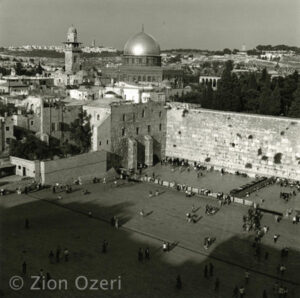 Renowned Jewish photographer Zion Ozeri is no stranger to creating meaningful Haggadot. His award-winning photographs, which capture the world around him, have appeared in The New York Times, Newsweek, The Jerusalem Report, Moment and The Economist, to name a few publications.
Renowned Jewish photographer Zion Ozeri is no stranger to creating meaningful Haggadot. His award-winning photographs, which capture the world around him, have appeared in The New York Times, Newsweek, The Jerusalem Report, Moment and The Economist, to name a few publications.
After reviewing his pieces, Ozeri decided to create a virtual interactive Haggadah that highlights the diversity of Jews, just in time for a second pandemic Passover.
Ozeri, along with Sara Wolkenfeld and Josh Feinberg, curated “Pictures Tell: A Passover Haggadah,” a Haggadah that is completely virtual (can be utilized at home or in a classroom) and celebrates the traditions and cultural experiences of the Jewish Diaspora. Ozeri told the Journal that a major goal of “Pictures Tell” is using imagery to tell the story of the Jewish people.
Source: https://jewishjournal.com/photographer-zion-ozeri-showcases-jewish-diversity-in-virtual-haggadah/
The Art Of Cooking – Aruk
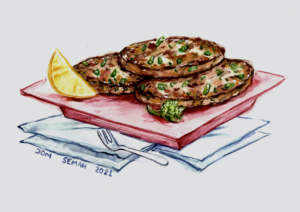 There is nothing better than a fried crispy Aruk!
There is nothing better than a fried crispy Aruk!
Well, this Aruk resembles the Iraqi herb and potato patties; however, this version is without the potato.
Whenever I think about something like comfort food, I am thinking about eating an Aruk or even a Latke!
Not only the taste but this is usually pretty easy to make – to become the highlight of the day!
Ingredients:
3 large onions
Fresh parsley
2 eggs
100-gram minced chicken meat or alternatively minced turkey meat
Kurkuma
Salt and pepper
Flour
Cooking oil
Making the Aruk:
Start with grinding 3 onions in the blender. Loosely chop up the fresh parsley and mix it together in the bowl with the onion paste – then add the minced meat, together with a large teaspoon of salt, pepper, and kurkuma.
Mix everything together, then add the 2 eggs and continue to mix.
Add some flour until the mixture turned into a thick paste and is not too watery -however, do not add too much flour.
In a skillet or a frying pan add a generous layer of cooking oil on medium heat, when the oil is hot add scoups of the Aruk paste and let it fry on one side until golden brown and then flip.
When both sides are golden brown and crispy remove them from the oil and place them on a paper towel.
Aruk tastes great as a side dish during a nice dinner or as a perfect snack during lunchtimes.
It is always a good time to have some Aruk! it tastes best hot with some freshly squeezed lemon on top.


